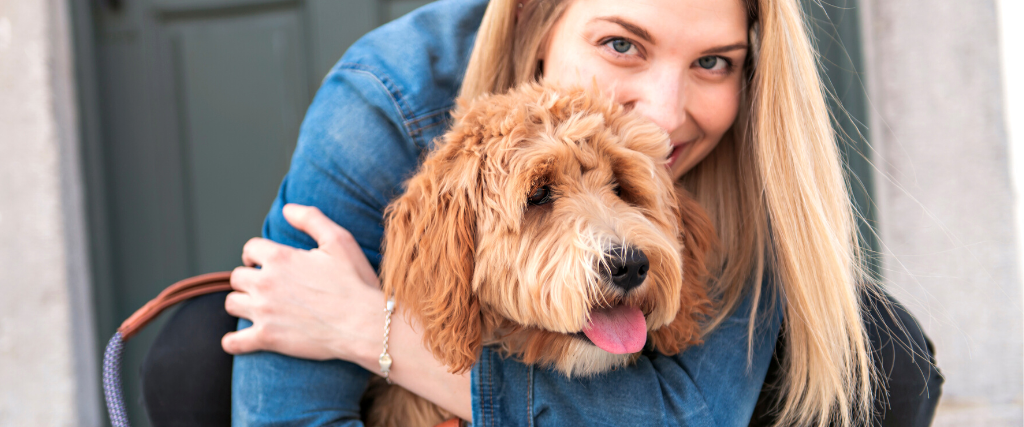Designer dogs have exploded in popularity in recent years, with many considering them the ideal dog with only the best characteristics of both parents. While that is true to some extent, it’s important to fully understand the pros and cons of designer dogs before adding one to your family.
What is a Designer Dog?
A designer dog is a cross between two purebred dogs strategically bred to create ideal characteristic combinations. For example, a Saint Berdoodle is a mix between a Saint Bernard and a Standard Poodle, resulting in a large breed dog that resembles an oversized teddy bear. They are great family dogs, laid back, and intelligent thanks to their combination of traits. The notorious Goldendoodle is a cross between a Golden Retriever and a Poodle, with the Golden Retriever's loving disposition and the Poodle's non-shedding fur, making them a highly-sought dog.
Poodles are a common purebred used to create designer dogs due to their intelligence and the fact that they are less allergenic, with the outcome being adorable, smart dogs that shed very little. A designer dog is not a breed—it’s a hybrid. They are strategically bred to optimize the positive characteristics of their purebred parents.

The Good
There is plenty of good when it comes to designer dogs, from great genetics to their cute appearance.
The positive aspects of designer dogs include the following:
- They’re off-the-charts adorable. Most designer dogs are fluffy teddy bear-like dogs with ultra-soft fur and big, round eyes that make them adored by all who cross their path.
- Designer dogs are carefully-bred, producing puppies that exemplify the best qualities of both parents.
- Due to crossbreeding, enhanced genetics are typical of designer dogs, while inbreeding results in weakened genetics. The percentage of designer dogs with genetic problems is considerably lower than purebred dogs due to their mixed gene pool.
- The outcome isn’t 100% predictable with each litter, but it’s far more predictable than mixed breeding without the positive intent of creating dogs with positive traits.
The Bad
While it’s hard to overlook the appearance and charm of designer dogs, there are some not-so-positive aspects.
The negative aspects of designer dogs include the following:
- Due to the high demand, designer dogs are expensive. It’s not unheard of to spend more than $2,000 to purchase a designer dog, as breeders are well-aware of their current popularity.
- Designer dogs don’t have a registry or a way to ensure the puppy you are getting comes from a good line or is even the right mix you are looking for.
- There is an inconsistency factor due to the combination of breeds, unlike breeding purebreds with very consistent results. For example, breeding a Golden Retriever and a Standard Poodle to create a Goldendoodle will sometimes produce a low-shedding dog with a curly coat, while other times, the litter will have a coat similar to a Golden Retriever that requires daily vacuuming. This can lead to disappointed buyers who have a preconceived notion of their puppy’s characteristics and the maintenance involved.
- Recessive traits—the traits you don’t want purebreds to pass along to their designer offspring—sometimes appear. For example, breeding a Labrador and a Poodle to create a Labradoodle could result in dogs who develop hip dysplasia, which is common in Labradors. A Puggle (Pug/beagle cross) is still considered a brachycephalic dog and may still have breathing problems like its pug ancestor.
- Due to their extreme popularity, some “backyard breeders” will breed these dogs without care for their health or even basic hygiene. Be sure to do some “homework” before buying a designer dog to ensure you are purchasing from a reputable breeder. Insist on proper paperwork, health testing, and vaccine records on the puppy and be sure to meet the parents and inspect the environment where the puppy is housed. Just because you’re paying a premium price does not ensure adequate preventive care and health.

The Truth
According to the ASPCA, approximately 3.1 million dogs live in animal shelters, only 2 million are adopted yearly, and 390,000 are euthanized annually due to space limitations.
The popularity of designer dogs has only exacerbated this issue, with individuals and families skipping the visit to the local shelter and instead opting for designer dog breeders. This is unfortunate, as shelters across the U.S. are home to countless hybrid dogs with all the same characteristics as designer dogs—loving, loyal, even-tempered, and adorable.
Those looking to add a dog to their family should always visit a local shelter first, as they might fall in love with a dog in need of a home and can skip the hefty expense of a designer dog.
If you are considering adopting a designer dog, contact us to learn more about the pros and cons so you can ensure they live a long, healthy life.

